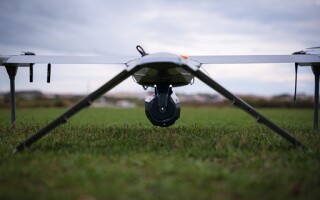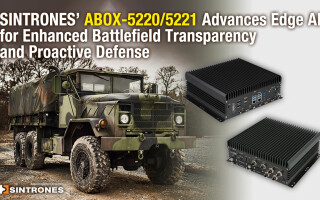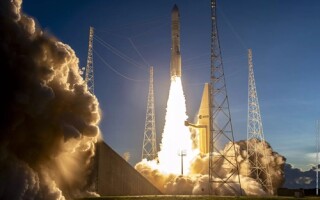GaN use in radar/EW applications gets hot
StoryFebruary 13, 2017
Military radar and electronic warfare (EW) designers continue to invest in gallium nitride (GaN) technology for its performance advantages. Meanwhile, the overall military radio frequency (RF) and microwave market continues to be strong, as advances in phased-array systems and other complex applications depend more and more on these components.
The use of gallium nitride (GaN) components is growing fast in military radar and EW system designs as an alternative or replacement for laterally diffused MOSFET (LDMOS) components. However, some industry experts say the customer base could use more education on GaN’s benefits and where and when to use it.
“The benefits that GaN features provide are well publicized, but the relative position of GaN versus other device technology requires careful review based on the design parameters of a particular application,” says Gavin Smith, RF Industrial Product Marketing at NXP (Phoenix, Ariz.). “GaN is a rapidly evolving technology, but so are other power semiconductor technologies. New applications emerge over time. For example, GaN got its ‘trial by fire’ in defense systems, but is already making significant inroads into wireless infrastructure and several other sectors, all in the span of less than 10 years.
“Of the RF and microwave semiconductor technologies GaN is the newest, and its characteristics and requirements are unique from the others,” Smith continues. “For example, its power-up sequence must be strictly adhered to, and as GaN has very high power density, circuits incorporating GaN devices must be designed to dissipate large amounts of heat. These are just two of the many factors that must be considered, beginning at the very earliest stages of design.”
Despite the huge interest in GaN technology, there is still uncertainty among the user base as to when to leverage GaN and when to leverage LDMOS.
“From my perspective, there seems to be confusion as to when to choose GaN components as opposed to LDMOS and gallium arsenide (GaAs),” says Bryan Goldstein, general manager of the Aerospace and Defense business at Analog Devices (Chelmsford, Mass.). “In some applications the answer is very clear, and in others it is not so clear. If the application requires efficient, pure saturated RF output power at frequencies above 4 to 5 GHz, and power levels above 5 to 7 W, then GaN is the clear choice. However, GaN has much worse linearity characteristics than GaAs, so for communication applications where linearity is critical, tradeoffs need to be made between combining multiple GaAs amplifiers, which are much more linear, or working with a significantly lower number of GaN devices. In the area of low noise amplifiers (LNAs) and RF switches, the performance being achieved on GaN is now coming close to matching that of GaAs in terms of gain/loss and noise figure while achieving much higher levels of power handling. As the volume of GaN increases and the cost decreases, it is expected that GaN will replace GaAs for many future applications. Where LDMOS maintains its position is in the area of power amplifiers below 4 to 5 GHz. Power levels on par with, if not superior to, GaN can be achieved at a fraction of the current price point. So in these applications, LDMOS will remain strong.”
As GaN’s price point comes down with each generation, users are able to find new applications for the technology and understand better where it fits with LDMOS.
“GaN’s performance benefits are well known to all involved with the RF and microwave industry today,” say Dr. Doug Carlson, vice president of strategy, and Thomas Galluccio, director of marketing, aerospace and defense at MACOM (Lowell, Mass.). “But GaN’s historical cost structure made it prohibitively expensive, which slowed its mainstream adoption. This is no longer the case, however, and customers’ perceptions and expectations for GaN are evolving accordingly.
“Taking into account the inherent power density advantage and scalability to eight-inch substrates, Gen 4 GaN on silicon (GaN on Si) is expected to yield GaN-based devices that are half the semiconductor cost per watt of comparable LDMOS products and significantly lower cost than comparably performing but more expensive GaN on silicon carbide (GaN on SiC) wafers at volume-production levels,” they continue. “So parallel advancements in the GaN supply chain and GaN technology roadmap have enabled the manufacturing scale and cost structures necessary to allow GaN to penetrate into commercial domains like wireless base stations, RF energy applications, and beyond. For customers evaluating where GaN does and doesn’t fit based on performance and cost metrics, Gen 4 GaN changes the equation considerably.”
Military RF and microwave outlook
GaN continues to gain momentum among military system designers, a fact that is also emblematic of the overall health of the military RF and microwave market.
“We anticipate that the demand for RF and microwave technology will continue to grow for military radar applications,” say Carlson and Gallucio. “Active electronically scanned arrays (AESAs) will play an increasingly vital role within the overall sensor mesh network, spanning air, land, sea, and space domains. And as these systems become more affordable and easier to manufacture, their proliferation will accelerate. At the system level, the number of RF elements onboard an AESA is considerably higher than with legacy radar systems. As AESA deployments ramp up, the aggregate RF content footprint expands exponentially.”
NXP’s Smith says that his company focuses their products for aerospace and defense applications on “three major areas: radar, communications, and EW. RF is an essential component in radar applications for DME [distance measuring equipment], TACAN [tactical air navigation system], IFF [identification friend or foe], data links, and more. Although it can take several years to update current systems, the need for technological advances is clear to us.”
New radar systems and EW systems are only getting more complex: Whether it’s the transition to phased-array antennas or developing cognitive EW capability, the complexity and volume of electronic components is only going to increase.
“RF and microwave technology is prevalent in radar, electronic surveillance/countermeasures, and communications systems for military and space applications,” Goldstein says. “As radar systems transition to phased-array antenna, the volume of electronics required increases dramatically from less accurate and less reliable single-rotating-antenna architectures. New radars will have thousands of antenna elements and these architectures will require RF and microwave electronics in the areas of transmit/receive functionality, up/down conversion, and frequency synthesis. Electronic countermeasures/surveillance has been made a priority by the U.S. government; new initiatives require RF and microwave components with wider bandwidths, improved efficiencies, and faster frequency-hopping capabilities.
“The new communications architectures are being simplified by integrated radio-on-a-chip silicon solutions,” Goldstein continues. “These new transceiver chips include transmit and receive high-speed converters and frequency up-conversion with frequencies currently as high as 6 GHz. This single-chip solution covers many current military communications applications, which require operating frequencies up through Ka-Band, such as VSAT. These utilize these new transceivers, which can then be cascaded with further RF and microwave content to achieve higher frequency bands. As you can see, these applications are full of microwave content and these areas are the focus of new systems and system upgrades needed by the aerospace and defense industry.”
Moreover, the automotive market’s investment in radar technology will also help drive innovation and cost reductions due to the high volumes of that industry, Goldstein says. New products have been released that are focused on 24-GHz and 77-GHz automotive radar applications, he notes. “The continued cost reductions achieved through high levels of integration on silicon have enabled the introduction of radar sensors on most models of new automobiles. The volume of cars utilizing RF and microwave technology is growing very quickly.”





